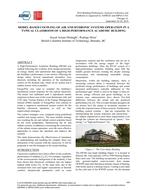Description
A High-Performance Academic Building (HPAB) was studied following the evidence from design documents, an energy model, and operational data suggesting that the building’s performance is not entirely reflecting the design intent. Several operational anomalies were detected, including the operation of the mechanical system on the demand side, where an air system and a radiant system work in parallel. EnergyPlus was used to simulate the building’s mechanical system response for one typical classroom. The model was calibrated until it reproduced similar responses to those seen in the room thermostat, slab, and VAV data. Various features of the Energy Management System (EMS) module of EnergyPlus were utilized to create a responsive mechanical system control for the baseline classroom operation, as well as four improvement strategies. The control strategies were compared using predefined comfort and energy metrics. The most suitable strategy was resetting the air and radiant system setpoints based on the room temperature. Harmonizing the air and radiant systems, in addition to increasing the consistency of the radiant system operation, were the most effective approaches to reduce the operation and improve the comfort. The study demonstrates the effectiveness of simulation in understanding and handling the complex three-way interaction of the systems with the classroom. It will be proposed to test the strategies in the actual building.
Citation: ASHRAE/IBPSA-USA Bldg Simulation Conf, Sept 2018
Product Details
- Published:
- 2018
- Number of Pages:
- 8
- Units of Measure:
- Dual
- File Size:
- 1 file , 2.9 MB
- Product Code(s):
- D-BSC18-C057




